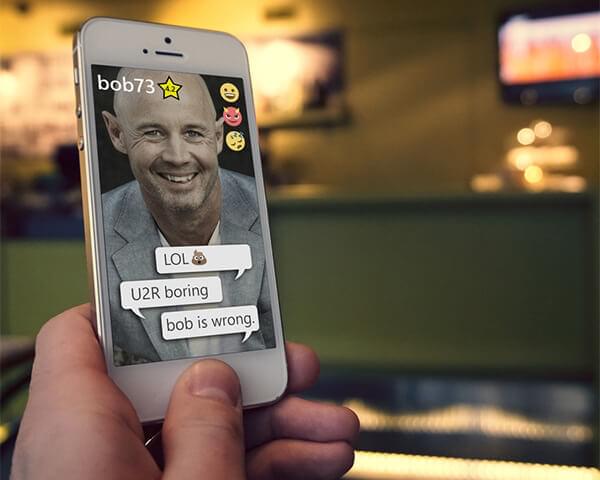Social Media 2.0: Real Life Augmentation

Social media platforms such as MySpace, Bebo, Facebook, Twitter, Snapchat, Instagram, LinkedIn and Google+ have been transformative technologies which shaped the early years of the twenty-first century. People can meet, interact and communicate in ways which would have been impossible a decade earlier.
Despite the ongoing success of social networks, most people’s real and online lives rarely connect in a cohesive manner:
- you have a long list of online “friends” you’ve never met, know or speak with
- your actual friends use different social networks to you
- you disconnect from real-world conversations to join online virtual chats
- you’ll reprimand people for talking nonsense yet believe identical online articles and alerts
- you feel obliged to comment on online articles despite not reading the text or understanding the points raised
- you’ll say things online which would never be said in person-to-person conversations.
Most people live separate online and offline lives. Some even adopt a different online image or persona.
Augmented Reality Social Experiment
Smartphone systems such as Siri and Cortana and screenless devices such as Amazon Echo and Google Home have already begun to revolutionize how we interact with devices. The next step is the Augmented Reality Social Experiment which will finally end the distinction between your real and online lives.
Dr Truly Lyse, the CTO of Distributed Reality Open Social Systems, claims their new software heralds the start of Social Media 2.0:
Starting in April 2017, our Social/Human Interface Technology software will be automatically installed on all your online devices. It will bridge the missing link between disparate social media platforms and real-world activities.
The new system blends social media networks with Augmented Reality to introduce a new level of sophisticated integration between the real and virtual worlds:
- Your face-to-face meetings and conversations will be live-streamed. Audio and text translations will be shared and made instantly available on all your connected social media networks.
- Holding your phone up will automatically record and upload video (bandwidth-permitting). The view is overlaid by further information as necessary.
- Your friends and followers can access your real-world interactions in real time.
- Any of your online contacts can join in the conversation, add comments, submit emojis and rate your discussion.
- Disputes can be settled instantly with online voting to determine who is right or wrong.
Lyse states:
Your real-life conversations will be infinitely enhanced by the addition of other collaborators. The wisdom of crowds is a positive phenomenon: it has been proved infallible in polls, elections and referendums.
Viral Dominance
Your real-world conversations with friends, family and colleagues could make you an instant internet sensation as your discussions go viral and are shared throughout the community. However, Lyse points out the technology will quickly evolve beyond simple interaction enhancements.
Online data input activities will require less effort because the system will be able to recognize your likes, dislikes, habits, relationship statuses and emotional well-being. Friends will know whether you’re hungry, tired, frustrated or euphoric by viewing icons superimposed on your face.
Conversations can be data-mined to highlight media and marketing trends. Your discussion will receive useful interruptions for associated products and news alerts. For example, if you’re feeling unwell, the system can recommend remedies which have been highly rated by others in your social group for similar symptoms.
Finally, your reputation will be enhanced by the quality of your real-life interactions. Others can rate factors such as your intelligence, empathy, confidence and sense of humor to provide an aggregate personality score. Your ranking will become increasingly important:
- It will be more meaningful than a resume for employers.
- Potential partners can filter requests and automatically accept or reject an approach.
The End of Privacy?
Social/Human Interface Technology is not without its critics and there have been privacy concerns. Your PC, smartphone and screenless devices will have received, installed and activated the software by the time you read this article, but strict safeguards and privacy protocols are in place.
You can switch off live-streaming when you want to start a private conversation. To enable private system mode, speak the following activation words clearly into your device:
ENGAGE PRIVATES
Your device will confirm with an audible alert and/or the message “PRIVATE SYSTEM MODE ACTIVATED”. Private system mode will remain engaged until you end the conversation or say:
DISCHARGE PRIVATES
 Alternatively, you can wear a privacy hat. The Social/Human Interface Technology software uses real-time video image recognition and microwave distortion analysis to identify the head-wear of all parties. Private system mode is activated when one or more of your conversation group is wearing the hat so nothing is shared online.
Alternatively, you can wear a privacy hat. The Social/Human Interface Technology software uses real-time video image recognition and microwave distortion analysis to identify the head-wear of all parties. Private system mode is activated when one or more of your conversation group is wearing the hat so nothing is shared online.
There have been supply problems in some parts of the world, but you can make your own privacy hat with a standard sheet of tin foil.
The Future of Social Media
Augmented Reality is the obvious next step for social media. All the popular networks have integrated Social/Human Interface Technology so the system is usable today. Early beta test results were promising, but there will undoubtedly be teething problems during the world-wide launch.
Have you used Social Media 2.0 on your devices? Was the experience positive or negative? Comments welcome.


